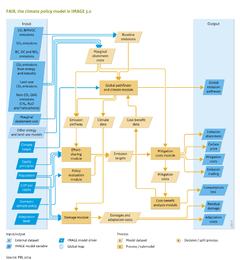Climate policy/Policy issues: Difference between revisions
Jump to navigation
Jump to search
No edit summary |
No edit summary |
||
| Line 8: | Line 8: | ||
<div class=“version changev31”> | <div class=“version changev31”> | ||
*Evaluation of current reduction proposals by countries and policy options for the next 10 to 20 years ([[European Commission, 2010]]; [[Den Elzen et al., 2011a]]; [[Den Elzen et al., 2011b|2011b]]; [[Den Elzen et al., 2012b|2012b]]; [[UNEP, 2012]]; [[Hof et al., 2013]]; [[UNEP (2016)]]); | |||
*Evaluation of current reduction proposals by countries and policy options for the next 10 to 20 years ([[European Commission, 2010]]; [[Den Elzen et al., 2011a]]; [[Den Elzen et al., 2011b|2011b]]; [[Den Elzen et al., 2012b|2012b]]; [[UNEP, 2012]]; [[Hof et al., 2013]]; [[UNEP (2016)]]; [[Den Elzen et al., 2016]]); | |||
</div> | </div> | ||
| Line 32: | Line 34: | ||
As shown in the figure below, all reductions result from reduced emissions from deforestation (REDD). The contributions from {{abbrTemplate|REDD}} projects (about 560 MtCO2) are expected to exceed or match the required total reduction in all greenhouse gas emissions of 470 and 570 Mt CO2eq for the 36% and 39% reduction pledge scenarios. | As shown in the figure below, all reductions result from reduced emissions from deforestation (REDD). The contributions from {{abbrTemplate|REDD}} projects (about 560 MtCO2) are expected to exceed or match the required total reduction in all greenhouse gas emissions of 470 and 570 Mt CO2eq for the 36% and 39% reduction pledge scenarios. | ||
|Example=<div class=“version changev31”> | |Example=<div class=“version changev31”> | ||
The Global Pathfinder module FAIR-SiMCaP was used to determine what the pledges for 2020 imply for global emission pathways consistent with meeting the 2 °C target ([[Van Vliet et al., 2012]]). The main findings were as follows (see also the figure below): | The Global Pathfinder module FAIR-SiMCaP was used to determine what the pledges for 2020 and the {{abbrTemplate|INDC}} targets (mainly for 2030) imply for global emission pathways consistent with meeting the 2 °C target ([[Van Vliet et al., 2012]], [[UNEP (2016)]], [[Den Elzen et al., 2016]];). The main findings were as follows (see also the figure below): | ||
</div> | </div> | ||
* The global 2020 emission level resulting from implementation of the Copenhagen Accord pledges exceeds those of least-cost pathways that achieve a 2 °C target; | * The global 2020 emission level resulting from implementation of the Copenhagen Accord pledges exceeds those of least-cost pathways that achieve a 2 °C target; | ||
Revision as of 20:28, 6 November 2016
Parts of Climate policy/Policy issues
